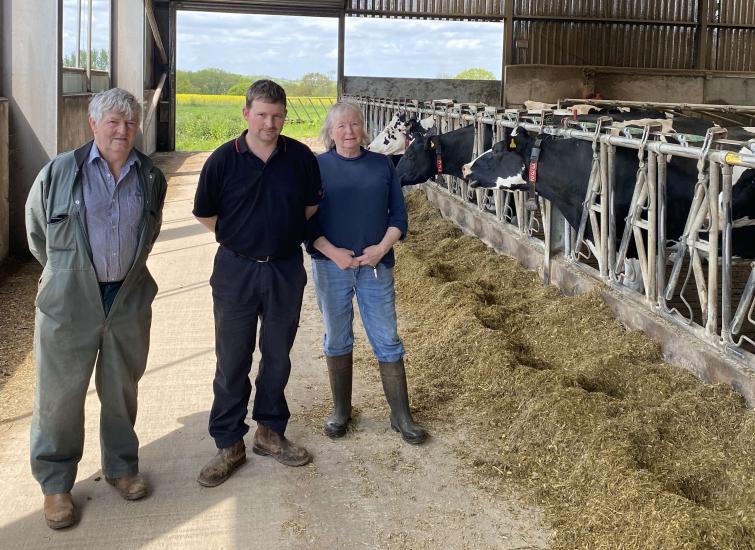We feel that by working with Advanced Nutrition, they are always looking at the bigger picture. They help us to plan ahead as well as keeping the Jersey herd running day-to-day. New ideas on management of the herd are always coming from Advanced Nutrition.
Utilising Robotic Milking Data to Refine Cow Nutrition
Increasing rumen stability and improving cow transition health is the key to profitability on one Gloucestershire farm using a robotic milking system. First published in British Dairying August 2023 edition.

Richard Baker farms at Close Turf in St. Briavels Gloucester, a dairy and arable unit run in partnership with his dad Brian and mum Carol. In 2017 The family installed two Lely A4 Astronauts and have since expanded the Holstein herd to 140 with 120 milkers.
But despite the initial transition working well, they later ran into a few dietary problems, so started working with Advanced Ruminant Nutrition’s Dylan Pinker in July 2022. “We were looking for a company that had experience in herd management and nutrition, and experience of all things robot,” says Richard. “We really liked their technical and progressive approach.”
Boosting yields
The partnership has worked out well, with yields substantially increasing from 29kg to 37kg in less than 12 months. “Following robot installation, the herd adapted quickly and settled into the new milking system,” says Dylan. “As we expect with herds moving from twice-a-day milking in the parlour to a robotic system, the milk yields increase with the additional milking frequency. However, this initial increase isn’t always sustained - this is where we see the benefit of the Advanced Robot triangle approach, working to balance the robot settings with nutrition, health and management. “We find that this balance works to sustain milk increases in the herds we work with.” When he started working with the Bakers, Dylan focused on adjusting the feed allocation and milk access settings to balance them with the nutrition fed at the trough. This followed a rigorous farm audit to highlight any bottlenecks holding the herd back. Dylan identified a problem with rumen instability in the lactating cows, coupled with a poor transition diet. This was resulting in several health problems affecting both the milking herd and the dry cows.
Rumen instability
“Cows were experiencing rumen instability from the beginning of lactation, causing several niggly under-lying health problems,” he says. “Body condition was inconsistent throughout, and within different stages of lactation. We attributed it to the fact that the transition and milking diets were not marrying up, causing rumen health problems.”
Fresh cows were peaking at 40kg/day with second calvers onwards averaging 31kg. Many of the cows were gaining weight rapidly through-out the lactation, which led to poor milking persistency. The high condition score cows would then head into the dry period far too fit which, when paired with a poor transition diet, led to a substandard transition, and a bad start to lactation. “This then had a knock-on effect within the herd for the following lactation – basically a vicious cycle.”
The Bakers increased dietary fibre, being careful not to compromise on milk quality and performance. However, it wasn’t just about look-ing at the diet. They continually monitored cows’ environment and adjusted the robot settings as they interpreted the data coming through. “We tweaked the milk access and feed tables to meet the needs of freshly calved cows and heifers,” says Dylan. “Body condition scores (BCS) were also carefully monitored and maintained to ensure that they remained consistent for both the dry cows and milking herd.
Simple system
“We significantly adjusted the dry cow diet, moving to a simple feeding system which has allowed cows to maintain BCS throughout the dry period, calving down without mobilising too much body fat. It’s all about intakes in the dry period, and attention to detail,” he adds. When cows are on robots, experience and a whole farm approach are key to getting the best out of the new technology. Being able to interpret the data and view the interrelationship between nutrition and environment is crucial, notes Dylan. The Bakers’ improved results came almost immediately after the diet and robot settings were changed. Not only has milk yield increased significantly from 29– 37kgs, but milk solids have also been sustained at 4.2BF & 3.4P, with total milk solids at 2.73kgms sold. By completely re-vamping the dry cow diets, overall cow health has improved, safeguarding herd longevity and milk persistency. With increased yields, the overall feed rate has decreased from 0.4 to 0.35 which has vastly improved margin over all feed.” The Baker’s have bred great cows giving us a solid base to work with, average milk speed is 3.2kgs/min and box time at 6.36 mins which allows us to work the robots to their full potential. We can push the limits on free time, and currently sit at 2265kgs/milk/robot”
Footbaths have also been installed at robot exits following the recommendation from the Advanced Robot team, which has seen digital dermatitis brought under control through better management. Increasing foot health and mobility is a key factor in improved milk yields for robotic milked cows.
Richard Baker comments, “Having independent advice from the Advanced Robot division to really analyse the herd and interpret the robot data to get the diet right has been invaluable. Although, the focus has largely been on our milking herd and dry cows, the adjustments in the diet also meant that colostrum improved to benefit calf health and DLWG.”
Dylan is continuing work with the Baker’s to continue to increase margin on the farm. Over the next year they will be working together to look at forage management, taking advantage of the homegrown feeds from the arable operations, as well as exploring increasing feed efficiencies by amino acid balancing.
〈 BACK



